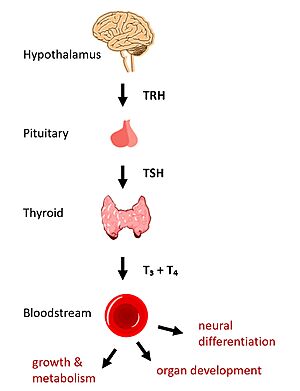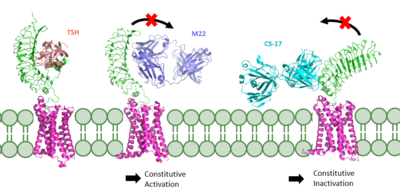Sandbox Reserved 1774
From Proteopedia
(Difference between revisions)
| Line 5: | Line 5: | ||
== Introduction == | == Introduction == | ||
| - | [[Image:HPT Axis.jpg|300 px|right|thumb|Figure 1: TSHR binds TSH in the HPT signaling axis pathway, which regulates metabolism and growth.]] | + | [[Image:HPT Axis.jpg|300 px|right|thumb|Figure 1: TSHR on the surface of thyroid cells binds TSH ligand secreted by the anterior pituitary in the HPT signaling axis pathway, which regulates metabolism and growth.]] |
| - | In humans, the hypothalamic-pituitary-thyroid (HPT) signaling axis regulates functions including metabolism, growth, organ development, and neural differentiation <ref name="Brent">Brent GA. Mechanisms of thyroid hormone action. J Clin Invest. 2012;122(9):3035-3043. [https://doi.org/10.1172/JCI60047 DOI: 10.1172/JCI60047]</ref>. In this pathway, the thyroid stimulating hormone receptor (TSHR) activates transcription of thyroid hormones in response to ligand binding by thyroid stimulating hormone (TSH). After a brief introduction to the biological significance of TSHR, this page explores the structure of TSHR and its significance to TSH binding and receptor activation. | + | In humans, the hypothalamic-pituitary-thyroid (HPT) signaling axis regulates functions including metabolism, growth, organ development, and neural differentiation <ref name="Brent">Brent GA. Mechanisms of thyroid hormone action. J Clin Invest. 2012;122(9):3035-3043. [https://doi.org/10.1172/JCI60047 DOI: 10.1172/JCI60047]</ref>. In this pathway, the thyroid stimulating hormone receptor (TSHR) activates transcription of thyroid hormones thyroxine (T3) and triiodothyronine (T4) in response to ligand binding by thyroid stimulating hormone (TSH). After a brief introduction to the biological significance of TSHR, this page explores the structure of TSHR and its significance to TSH binding and receptor activation. |
== Biological Significance of TSHR == | == Biological Significance of TSHR == | ||
| - | The HPT signaling axis involves the brain, thyroid gland, and bloodstream circulation. In the first step of the pathway, thyrotropin releasing hormone (TRH) is secreted by the hypothalamus, which in turn stimulates the anterior pituitary gland to produce TSH <ref name="Brent" />. TSH binds to TSHR on the surface of thyroid cells and triggers the production of | + | The HPT signaling axis involves the brain, thyroid gland, and bloodstream circulation. In the first step of the pathway, thyrotropin releasing hormone (TRH) is secreted by the hypothalamus, which in turn stimulates the anterior pituitary gland to produce TSH <ref name="Brent" />. TSH binds to TSHR on the surface of thyroid cells and triggers the production of T3 and T4 through through [https://www.ncbi.nlm.nih.gov/pmc/articles/PMC3967846/ G-protein coupled receptor (GPCR)] signaling <ref name="Chu">Chu YD, Yeh CT. The Molecular Function and Clinical Role of Thyroid Stimulating Hormone Receptor in Cancer Cells. Cells. 2020;9(7):1730. [https://doi.org/10.3390/cells9071730 DOI:10.3390/cells9071730]</ref>. T3 and T4 circulate in the bloodstream and enter cells via thyroid hormone transporters to regulate metabolic functions. Additionally, T3 and T4 act in a negative feedback loop to inhibit further TSH production <ref name="Brent" />. |
Dysregulation of TSHR can lead to disease. In [https://www.niddk.nih.gov/health-information/endocrine-diseases/graves-disease#:~:text=Graves'%20disease%20is%20an%20autoimmune,the%20way%20your%20heart%20beats. Grave's disease], antibody analogs of TSH cause overactivation of TSHR, leading to clinical symptoms of hyperthyroidism <ref name="Chu" />. In contrast, congenital mutations which inactivate TSHR can lead to hypothyroidism, which results in growth retardation and neurologic impairment if left untreated <ref name="Brent" />. | Dysregulation of TSHR can lead to disease. In [https://www.niddk.nih.gov/health-information/endocrine-diseases/graves-disease#:~:text=Graves'%20disease%20is%20an%20autoimmune,the%20way%20your%20heart%20beats. Grave's disease], antibody analogs of TSH cause overactivation of TSHR, leading to clinical symptoms of hyperthyroidism <ref name="Chu" />. In contrast, congenital mutations which inactivate TSHR can lead to hypothyroidism, which results in growth retardation and neurologic impairment if left untreated <ref name="Brent" />. | ||
Revision as of 21:59, 6 April 2023
| This Sandbox is Reserved from February 27 through August 31, 2023 for use in the course CH462 Biochemistry II taught by R. Jeremy Johnson at the Butler University, Indianapolis, USA. This reservation includes Sandbox Reserved 1765 through Sandbox Reserved 1795. |
To get started:
More help: Help:Editing |
| |||||||||||


